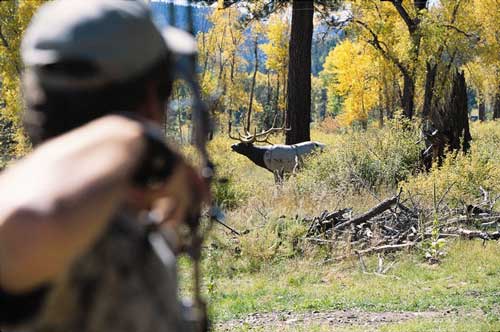Previously: Setup Considerations
It’s All About Kinetic Energy, Not Arrow Weight
 Kraus took a keen interest in elk equipment when his home state decided to implement new regulations for elk hunting that could possibly affect his archery shop business. In 2003 the South Dakota Game, Fish and Parks commission proposed to prohibit use of arrows that weigh less than 400 grains for elk. They also were proposing to prohibit the use of mechanical broadheads for elk. Kraus questioned these recommendations; especially the minimum arrow requirement for elk since it would virtually eliminate carbon arrows from elk hunting. Most of his personal carbon arrow setups were weighing in at approximately 370 grains and performing well on elk.
Kraus took a keen interest in elk equipment when his home state decided to implement new regulations for elk hunting that could possibly affect his archery shop business. In 2003 the South Dakota Game, Fish and Parks commission proposed to prohibit use of arrows that weigh less than 400 grains for elk. They also were proposing to prohibit the use of mechanical broadheads for elk. Kraus questioned these recommendations; especially the minimum arrow requirement for elk since it would virtually eliminate carbon arrows from elk hunting. Most of his personal carbon arrow setups were weighing in at approximately 370 grains and performing well on elk.
After studying the proposal, Kraus discovered the commission was putting too much emphasis on arrow weight and not considering the kinetic energy formula.
“They were thinking that arrow weight was the answer and came up with a 400-grain minimum weight for elk hunting. I knew that 400 grains was a bit too high since most carbon arrows weigh from 350 to 400 grains, especially when you consider most hunters use an arrow that measures 27-29 inches. Those generally weigh from 375 to 385 grains,” says Kraus. “To me this was going to basically outlaw the use of carbon arrows on elk. That didn’t sit well with me since 90 percent of the arrows we sell out of our shop are carbon and my own hunts clearly showed they were effective.”
Krause took his case to the commission, armed with data and show-and-tell tests. His data firmly detailed that speed was a key factor in the kinetic energy formula since it is a squared factor over arrow weight. He concluded that most modern bows shoot fast enough to create the needed kinetic energy to make carbon arrows effective in penetrating an elk.
For evidence, he showed the commission a half-inch piece of high-density plywood shot with both carbon and aluminum arrows. The lighter carbon arrow was shot from a modern compound bow and it penetrated to the arrow’s fletching. The heavy aluminum arrow was shot from a recurve bow of comparable weight. Just the tip penetrated. His case was won for the arrow weight, but mechanical broadheads were made illegal for bowhunting elk in South Dakota.
For kinetic energy to work properly, your arrow needs to be tipped with a razor-sharp broadhead. Most experts agree that a cut-on-impact broadhead is best, but after that, everyone has an opinion.
Forget about a mechanical in South Dakota, but you can use them in states like Colorado. Morris has been a fan of the Spitfire mechanical broadhead since 1995. One reason Morris doesn’t worry about using mechanical broadheads is that he shoots a fast bow producing loads of kinetic energy. While initially testing the Spitfire, he was shooting an 84-pound Hoyt. Today he hunts elk with a 71-pound Mathews, which still produces adequate kinetic energy to deploy the broadhead blades and penetrate an elk.
“I love my Spitfires on elk. I just love the way they perform for me. I’ve seen failure, but in nearly every instance, it wasn’t the broadhead’s fault. It was shot placement,” cautions Morris. “When a bull elk is rushing in and screaming it’s too much for the average bowhunter to take. After an encounter like that, I’ve seen bowhunters you could literally pour from their boots and that’s why the broadhead didn’t work. They had bad shot placement.”
Prepare Mentally
Morris believes bowhunters would be better served by preparing themselves mentally like professional athletes. Mental preparation is directly linked to shooting confidence. He recommends shooting a minimum of three times a week throughout the winter if you have a hunt booked for the upcoming fall. As the hunt draws closer, shoot at least 10 arrows every day and either shoot at a paper elk target or purchase a full-size 3-D elk target. He also stresses to shoot from your knees, not from a standing position, and to practice at targets in downhill and uphill positions.
Finally, he recommends watching as many elk hunting videos as possible, such as Hunter’s Specialties Primetime Bulls. Watching a variety of videos will give you an idea of how bulls approach a calling setup and give you a mental picture on how to set up to take advantage of a duped bull.
Most of you won’t need to overhaul your current setup, but an evaluation of your bowhunting tools is in order for an elk adventure. If your rig falls short, make sure to beef up for success on your next elk adventure.
Next: On Wounded Bulls






